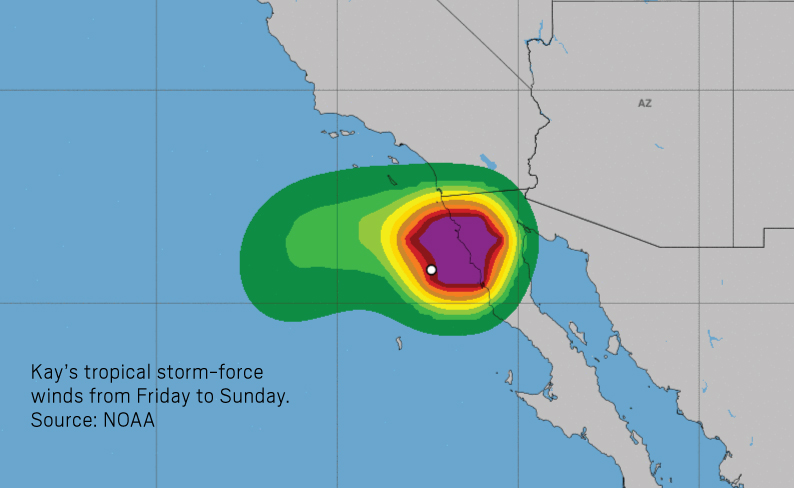
Hurricane Kay has been downgraded to a tropical cyclone, but it’s bringing wet weather to Southern California and could pour 2-4 inches of rain in some areas.
Major hurricanes rarely reach California, but the rain, thunderstorms, high surf and flash floods they bring can be problematic.
A tropical cyclone is a general term for an intense, low-pressure weather system that forms over and is fueled by warm ocean waters. In the North Atlantic Ocean and Eastern Pacific Ocean, strong tropical cyclones are called hurricanes, but they have other names in other ocean regions.
Hurricane winds rotate counterclockwise in the Northern Hemisphere. The strongest winds are in a hurricane’s eyewall, which surrounds a nearly calm eye at the storm’s center. A hurricane’s eye is typically miles in diameter. Clouds in the eyewall and the spiral bands outside it can produce very heavy rain.
Kay was at hurricane strength about 250 miles from San Diego, like only four other storms since 1950.
What’s in a name?
Hurricanes, cyclones and typhoons are the same type of storms. The only difference is the location. The map below shows where the differently named storms occur, as well as the average number of storms per year and the regions’ percentage of the total global average. The Gulf of Mexico and Caribbean account for 11% of the world’s hurricanes.
The use of short, distinctive names is quicker and less subject to error than cumbersome, latitude-longitude identification methods.In 1953, the United States abandoned a plan to name storms by a phonetic alphabet (Able, Baker, Charlie, for example) when a new, international phonetic alphabet was introduced. The U.S. used only female names for storms until 1978, when men’s names came into use for storms in the North Pacific. In 1979, male names were first given to storms in the Atlantic and Gulf of Mexico.
The current lists, which have been agreed upon at international meetings of the World Meteorological Organization, alternate between male and female names, and they have a French, Spanish, Dutch and English flavor because hurricanes affect and are tracked by many countries. Each list is recycled every six years, although storm names that have resulted in substantial damage or death (e.g., Ike, Katrina, Andrew, Betsy) are retired. The practice of retiring storm names began in 1954. As of the end of the 2010 Atlantic hurricane season, 75 storm names have been retired in the Atlantic Basin.
This year’s storm system names
Eastern North Pacific
Agatha
Blas
Celia
Darby
Estelle
Frank
Georgette
Howard
Ivette
Javier
Kay
Lester
Madeline
Newton
Orlene
Paine
Roslyn
Seymour
Tina
Virgil
Winifred
Xavier
Yolanda
Zeke
Wind scale
The Saffir-Simpson hurricane wind scale is a 1 to 5 rating based only on a hurricane’s maximum sustained wind speed. This scale does not take into account other potentially deadly hazards such as storm surges, rainfall flooding and tornadoes. The Saffir-Simpson scale estimates potential property damage.
Hurricane season
Hurricane season is at its peak. For Californians, the wildfire season is a big threat, and earthquakes can occur at any moment.
The figures below show the points of tropical cyclone genesis by 10-day periods at peak hurricane season. Named storms only. The source years are 1851-2015 for the Atlantic and 1949-2015 for the Eastern Pacific.
Preparedness month
Hurricane warnings can be sent out days ahead, but other disasters can hit without notice. September is National Preparedness Month, so take a little time to get ready. The American Red Cross and FEMA recommend every household have a kit prepared for an emergency. A rule of thumb is to have enough food and water for every family member and pet for three days.
Disaster kits are recommended for home, work and your car as well as a family emergency plan for where to meet and whom to contact. For more information, go to FEMA.gov.
Sources: National Oceanic and Atmospheric Administration, Federal Emergency Management Agency, National Weather Service, Redcross.org, National Hurricane Center
